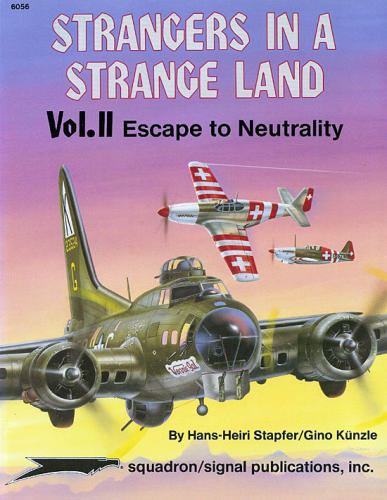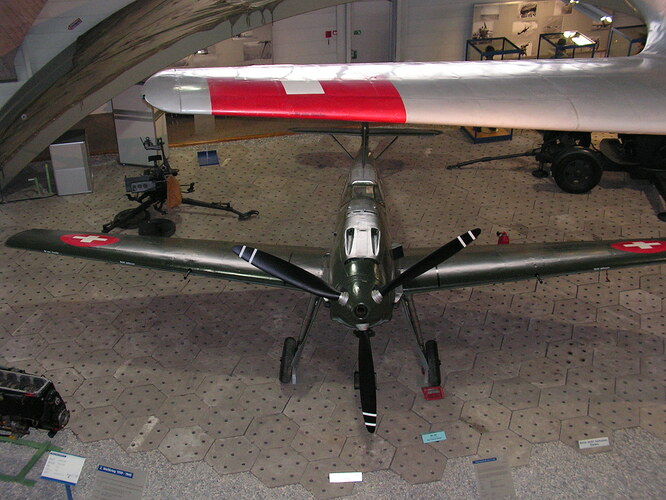Thanks Panzerknacker,
BTW, do you know of any large encounters between Swiss and German Bf-109’s during WWII. It seems that in the back of my mind I read of an incident where a flight of German Bf-109’s strayed into Swiss airspace and were forced to land in Switzerland where they were then interned. Haven’t been able to confirm it on the Web.
Here are more tidbits of information concerning the Swiss during WWII:
Swiss Bf-109’s
http://www.faqs.org/docs/air/avbf1093.html
-
Switzerland purchased a dozen Bf-109Ds in 1938, fitting them with four Swiss-built 7.45 millimeter machine guns. The cowling guns had 480 RPG while the wing guns had 418 RPG. The Doras were intended to provide familiarization for the 80 Emils that followed in 1939 and 1940. The Swiss Emils were also fitted with Swiss guns, as well as a Swiss radio.
The Swiss used their Bf-109Es in several furious dogfights with the Luftwaffe over airspace incursions during the invasion of France, with the Luftwaffe losing a handful of He-111s and Bf-110s, to the loss of a few Swiss Bf-109s.
Despite these fits of unneighborliness, the Swiss obtained a dozen Gustavs late in the war. They had placed an order with the Germans in 1943 but could not get delivery, until a Bf-110 night fighter carrying sophisticated electronics and armament strayed into Swiss airspace in late April 1944, and landed near Zurich due to engine trouble.
The Germans became more cooperative with the Swiss in delivering the Gustavs, bargaining with the Swiss for the destruction of the Bf-110 lest Allied intelligence get their hands on it. However, the Gustavs were of very shoddy quality and were “hanger queens”, and the Germans refunded half of what the Swiss paid for them.
Swiss Bf-109s also intercepted Allied bombers that strayed into their airspace, forcing them to land and be interned. There were rarely problems, but during one such incident, a USAAF P-51D Mustang shot down a Swiss Bf-109 and damaged another. The Swiss tried painting their Bf-109s with loud red and white stripes to emphasize the Swiss cross markings, but this was discontinued because the Luftwaffe mistook them as Allied aircraft painted in invasion stripes.
The Swiss interned a number of Luftwaffe Bf-109s during the war, and even built nine Bf-109Es themselves at the end of the war, one of them assembled from spares. The Swiss Bf-109s finally scrapped in 1949.
Combat Service with Switzerland
http://www.cassiopedia.org/wiki/index.php?title=Messerschmitt_Bf_109
Switzerland took delivery of its first Bf 109s in 1938 when 10 Bf 109Ds were delivered. After this, 80 E-3 were purchased which arrived from April 1939. During the war a [b]further four 109s (two Fs and two Gs) were acquired by the Swiss Air Force through internment.
In April 1944 12 further G-6 aircraft were acquired in exchange for the destruction of a highly secret Messerschmitt Me 110G nightfighter which made an emergency landing in Switzerland. The Swiss Air Force used their Bf 109Gs until 1946.[/b]
During the war the Swiss aircraft were painted in more and more colorful markings to avoid confusion with German 109s.
On May 10, 1940 air combat between Switzerland and Germany was initiated. Several Swiss Bf 109s engaged a German Dornier Do 17 near the border at Bütschwil; in the ensuing exchange of fire, the Dornier was hit and eventually forced to land near Altenrhein. The scene was repeated on May 16 when a German He 111 returned from France by way of Swiss airspace. Two Swiss fighters jumped the light bomber when it dropped down below cloud cover to de-ice its wings. The German aircraft was hit by machine gun fire and was further damaged by anti-aircraft fire near Zürich. Two injured flyers parachuted; the other two crew members went down with the plane and were captured.
On June 1 when the Germans sent 36 He 111s through Swiss airspace, Switzerland sustained its first casualty. Sub. Lt. Rudolf Rickenbacher was killed when his Bf 109 caught fire after being hit in the fuel tank by enemy fire.
On June 8 a C-35 observation plane, a relic biplane, was attacked over the Jura Mountains by two German Bf 110s. The pilot and observer were killed. Later on the same day, Swiss Captain Lindecker led about fifteen Swiss fighters against twenty-eight German planes. The Swiss pilots again displayed their ability in air to air combat, knocking three of the German planes from the sky and severely wounding the crew in a fourth. A Swiss Bf 109 was hit and damaged in the dogfight.
Title- Luftwaffe Colours Zerstorer Volume One; Luftwaffe Fighter- Bombers and Destroyers 1936-1940
Author- John J. Vasco
Publisher- Ian Allan Publishing
ISBN- 1903223571
Price- £16.99
Binding- Paperback Pages-96
http://www.randlesreviews.co.uk/4805/157374.html?sessionidkey=sessionidval
Of especial note are such fascinating details as the June 1940 over flight of Swiss territory by Luftwaffe aircraft resulting in Swiss Bf 109’s shooting down one of the escort and more when it was tried again on the 8th of June.
Aerial Dogfights
http://www.frontline.org.za/articles/reformation_resistance.htm
As the Western front opened on 10 May 1940 with a German invasion of Holland, Belgium and France, 27 bombs were dropped by the Luftwaffe on Northern Switzerland, and Swiss anti-aircraft guns drove away German bombers and fighters. A Swiss squadron of pursuit planes engaged the Luftwaffe and a Swiss ME-109 shot down a Heinkel-111, twin-engine bomber. This was the first of many instances in which the Swiss used aircraft, initially purchased from Germany, to shoot down Luftwaffe warplanes.
German reconnaissance aircraft, equipped with cameras, flying over the fortified Northern frontier of Switzerland, were driven away by anti-aircraft fire. On 1 June, 36 German bombers entered Swiss air space and were attacked by Swiss ME-109’s. Two HE-111 bombers were shot down. The next day another HE-111 was shot down by a Swiss fighter. On 4 June, as the British army was being evacuated from Dunkirk, the Swiss Air Force was engaged in an intensive dog-fight with 29 German planes. Both Luftwaffe and Swiss planes were shot down. One German aircraft had the following order on board: “Lure the Swiss fighters into battle and shoot down as many as possible.” On 8 June, it was David against Goliath again – 15 Swiss aircraft engaged 28 Luftwaffe planes, resulting in the downing of 2 Swiss and 3 German aircraft.
Target Switzerland
http://sonic.net/~bstone/archives/981111.shtml
As Allied strategic bombing of Germany intensified, more and more American bombers strayed over Switzerland. On 18 March 1944, sixteen crash-landed. On 1 April, 39 civilians were killed when a raid mistakenly hit Schaffhausen. On the 13th, thirteen US bombers overflew Switzerland; twelve were forced to land by Swiss fighters while the other, refusing to obey, was shot down. On 22 February 1945, American bombers accidentally hit Switzerland yet again and killed sixteen people. More deaths and damage resulted from raids on 4 and 11 March at Basel and Zurich. During the war, 166 American aircraft crashed or landed in Switzerland and 1700 American flyers were interned there.
On 25 August 1944, spearheads of American forces advancing from their landing beaches in the south of France reached the Swiss border near Geneva to re-establish a non-Axis frontier. Afterwards, more than 9000 Allied troops who had escaped into Switzerland during the course of the war – most from Axis POW camps – were released since they were classified as refugees. Interned Allied airmen were finally released in February 1945.
Swiss Mustangs
http://www.swissmustangs.ch/4655/4736.html?sessionidkey=sessionidval










